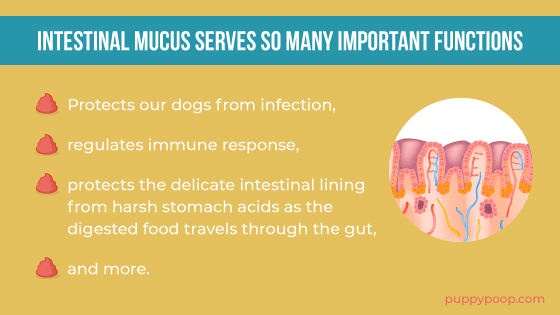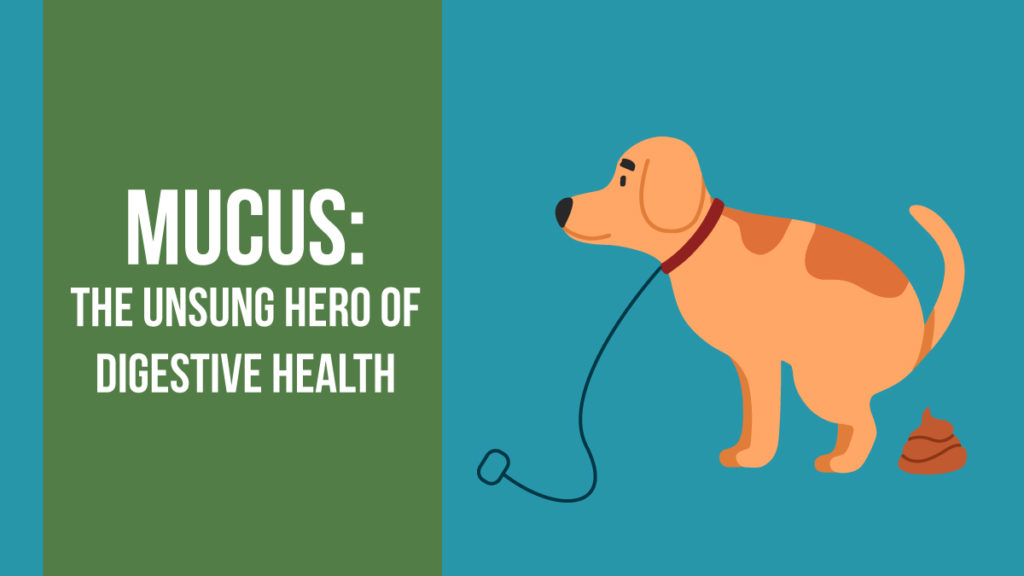You are walking your dog on a normal potty break, and when you go to pick up the poop, you see her poop is covered in mucus – a slimy, gooey coating. What is this? Why is it on there? She seems normal and healthy otherwise – is everything OK in there?
ALT: If you’re reading this article, chances are you’ve seen a slimy coated poop from your dog and are wondering – what is that coating and why is it there? of the four C’s: Consistency, Coating, Contents, and Color.
Mucus In Dog Poop
When thinking about the various by-products of digestion: vomit, urine and poop are among the first to pop to our minds. Mucus, while not as well-known or understood, couldn’t be more important. Mucus in dog poop helps protect our dogs’ digestive systems from germs and other intruders.
Intestinal mucus serves so many important functions:
- It protects our dogs from infection.
- Mucus regulates immune response.
- It protects the delicate intestinal lining from harsh stomach acids as the digested food travels through the gut.
- and more

Mucus layer (yellow) protects the intestinal finger-like villi to regulate exposure to nutrients and minimize pathogen invasion.
In this article, we will discuss the role of mucus – how it works, why it’s important, and when to be concerned.
What is Mucus?
Digestive mucus is a secretion comprising over 98% water. Mucus lives in the stomach and intestines, as well as other more obvious places like noses and mouths! Mucus resembles a clear, shiny goop, slime, or coating. Sometimes, mucus can make its way out of the GI tract during a bowel movement. When it does, it can look clear, opaque, or chunky. It can resemble a uniform coating on the entire stool surface, or cover only a section of the stool – a dog poop jelly substance, or yellow mucus could also be present. It may or may not be dog poop like jelly with blood.
Mucus in the Small Intestine:
Mucus serves as a single layer coating that protects the lining and acts as a gatekeeper – letting nutrients in and keeping germs out.
Mucus in the Stomach and Large Intestine:
In each of these organs, mucus comprises two layers – for the large intestine, the inner layer separates bacteria from the large intestinal lining, and the outer layer is home to the microbiota that reside there.
Mucus in the Intestines:
Mucus here can detach from the GI tract – this explains the slippery coating that sometimes accompanies your dog’s poop.
Mucus in a dog’s digestive system is especially important, for two key reasons:
- A dog’s digestive tract operates on a 9-hour schedule compared to our human schedule of 24-hours. Why is this important? The mucus lining must be in tip-top shape to ensure that healthy nutrients can absorbed, while the germs and nasties get filtered out as waste as mucus in dog poop.
- A dog’s stomach acidity can reach as low as pH 1.5 – the same as battery acid (a human’s stomach acid is around pH 3.0). With this acidity, mucus’ role in protecting the delicate small intestine lining is even more critical.
Why is Mucus Important?
One way to think of mucus, is as your dog’s personal translator between the outside world and its internal environment. Mucus decides what can contact the lining of the digestive tract, and what will get “trapped and eliminated” as mucus in dog poop.
When you see a mucus-coated stool, it could be a signal that the body has identified an irritant or a germ, and is trying to flush it from the body. This may happen very early in an infection, or with a diet change. In this case, the body detaches its mucus layer to get eliminated as waste. This is an example of the body’s first immune response kicking into gear.
Is Mucus in Stool a Cause for Concern?
Good news – not all mucus-coated stool is a cause for a veterinarian appointment. Usually, one or two bowel movements of coated, otherwise healthy-looking poop is a sign that the mucus has done its job. Mucus that accompanies stools over several days, or stool that is very loose or very hard may be a signal that something else could be awry. Consider consulting a veterinarian, and be sure to take a photo if possible.
Luckily, mucus does its job well 99.99% of the time – ensuring our dogs stay safe, healthy and protected. Unfortunately, sometimes mucus can let us down and germs can sneak through. When this happens, dogs can experience diarrhea, discomfort, bloating, and more.
While mucus is a super smart substance, some pathogens can outsmart mucus. For example, E.coli can live beneath the inner mucus layer, protecting it from clearance and elimination. These sneaky pathogens break through the mucus barrier by cutting their way through the mucus, and nestling into the small intestine. This is why bacterial pathogens can be so troublesome – dogs have a hard time battling and flushing these types.
Mucus – the Ultimate Bodyguard
Dogs have the shortest digestive tract of most mammals, averaging 6-8 hours. If your dog eats fresh food, like carrots, greens or peas, these harder to digest foods may come out in your dog’s poop if they’re not digested in time. Puree vegetables or legumes before feeding to help your dog’s digestive system.
In summary, Mucus is the intestine’s ultimate bodyguard. It allows for absorption of essential nutrients, vitamins and minerals, while defending against potential invaders. Also, mucus is providing a happy home to the microflora (the good bacteria) that aid digestion.
Because of the fleeting properties of this super-substance, it is quite challenging for scientists to study mucus. There is still a lot to learn when it comes to mucus in dog poop. The good news here is that it is not typically a cause for concern, unless it is accompanied by other symptoms, like diarrhea or blood.
Get the DIG Labs App
Download the free DIG Labs Digestive Health Tracker to get personalized insights and recommendations for your dog based on their stool.

